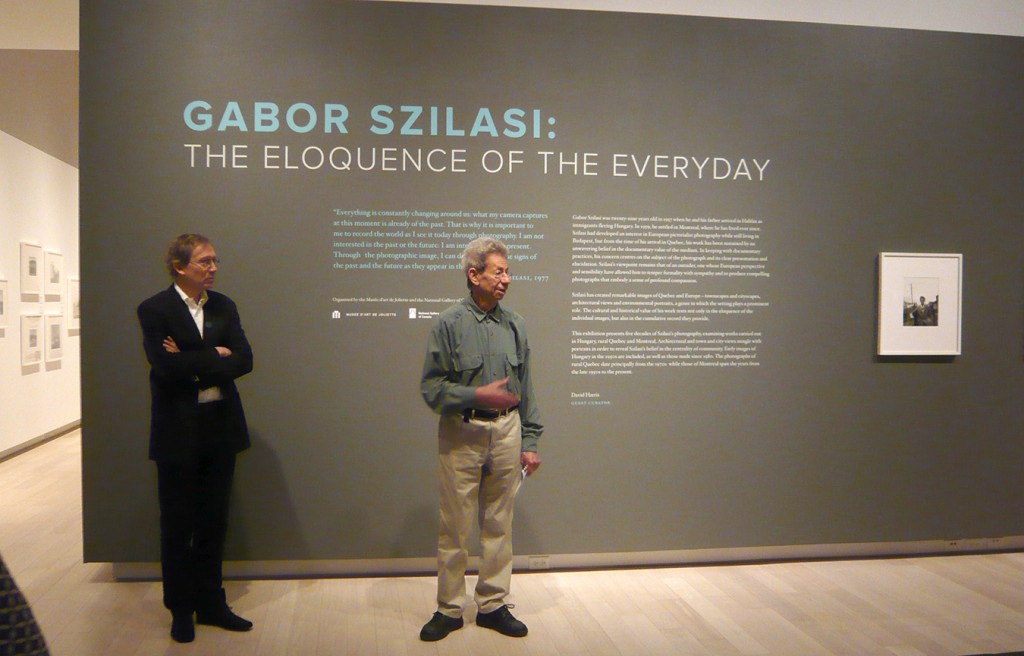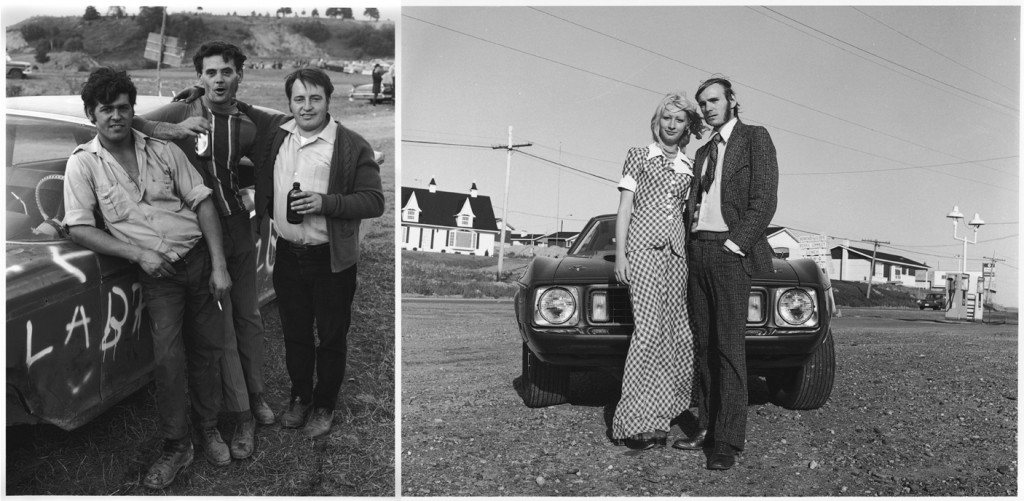Gabor Szilasi, the iconic Canadian Photographer, who influenced a few generations of photographers as an artist and as a teacher, has a wonderful show at the Ryerson Image Centre. The exhibition covers his oeuvre from the 1950s when he lived in Hungary, the rural Quebec series after he fled to Canada; his work in Montreal as well as his portraits.
 David Harris, Guest Curator (left), and artist Gabor Szilasi (right) during the press preview, June 18, 2013. Photo: Jennifer Park. Courtesy of the Ryerson Image Centre
David Harris, Guest Curator (left), and artist Gabor Szilasi (right) during the press preview, June 18, 2013. Photo: Jennifer Park. Courtesy of the Ryerson Image Centre
Szilasi is a wonderful storyteller, and I was lucky enough to look at his photographs and listen to the accompanying stories at the press preview. The exhibition is organized around the most important locations in Szilasi’s life: Budapest, rural Quebec and Montreal.
Gabor Szilasi, Gresham Building, looking towards Roosevelt tér, 5th District, Budapest, 1956. Collection of the artist. © Gabor Szilasi, 2009
Szilasi was born in Budapest. As a young man he was interested in art and wanted to be a painter. He was advised by a family friend to try photography since it didn’t require as much background knowledge. So he bought his first camera and started his photographic experiments, just for the fun of it. His first subjects included panoramic views of the city, buildings and the people who occupied them, his friends and strangers among them. In the Gresham Building, looking towards Roosevelt square (1956) the light and shadow capture a very artistic view with a somewhat dramatic feeling. Szilasi’s most famous work from that time called Motorcyclists at Lake Balaton (1954) was an “accident” created by the camera’s sudden exposure. The artist was on vacation, lying in the sand with his camera as it went off and just captured the couple driving out of the picture and because of the low viewpoint it chopped off the top of their heads. Unfortunately this composition became symbolic of the Hungarian Uprising against the Soviet occupation in October, 1956, when thousands of people died, I, a young child at that time, still remember the blood running on the street like rain. Szilasi captured some events of those terrible days, meetings, line ups for food and people fighting. Like many others, his family left Hungary and came to Canada in 1957.
Gabor Szilasi, Motorcyclists at Lake Balaton, 1954. Collection of the artist. © Gabor Szilasi, 2009
In 1980 Szilasi went back to Hungary and trough the following years nine other trips followed. His photographs from that time are mostly portraits of old friends he left behind. The interiors are heavy with memories look as if time stopped there with the old armoire, the chiming clock standing in the same place and the walls covered with books and artwork. Szilasi said that he knew even as a child about the process of memory and where memory is held. All of his photographs involve both the mind and the heart and each image has a history. His friend Adele sits in an overcrowded room in Budapest where every possible surface from floor to ceiling is covered with books and magazines. She sits there, her tired face showing the ravages of a hard life of a Hungarian intellectual, chain-smoking. Shortly after that photograph was taken, she fell asleep smoking, causing a fire. When she woke she tried to save all those books until she no longer could make it out and died among them.
Leaving the narrow streets and dark interiors of Budapest behind in 1956 and coming to Canada, Szilasi was surprised by all the open spaces of Northern Quebec. David Harris, the curator of the exhibition, called Szilasi’s photographs “environmental portraits.” It is especially true of the rural Quebec series. Working for the Office du Film du Quebec as a documentary photographer he travelled a lot and met people of all callings from poor farmers and physical labourers to the famous and rich.
 Left: Gabor Szilasi, Luc Simard, Édouard Guay, and Joseph Lajoie, standing beside stock car, Saint-Urbain, Charlevoix, September–October 1970. Right: Gabor Szilasi, Réjeanne and Gaétan Garon in front of the Bellevue Restaurant, Saint-Joseph-de-Beauce, Beauce, June 1973. Both Collection of the artist. © Gabor Szilasi, 2009
Left: Gabor Szilasi, Luc Simard, Édouard Guay, and Joseph Lajoie, standing beside stock car, Saint-Urbain, Charlevoix, September–October 1970. Right: Gabor Szilasi, Réjeanne and Gaétan Garon in front of the Bellevue Restaurant, Saint-Joseph-de-Beauce, Beauce, June 1973. Both Collection of the artist. © Gabor Szilasi, 2009
Szilasi took many images in Coudres, Charlevoix among them the portrait of the still beautiful, doll-like old lady Mme Alexis (Marie) Tremblay in her bedroom, Ile aux Coudres, Charlevoix (1970). She is posing for the photograph wearing lace a collar, a pristine white apron and a hat that was in fashion long ago. The mirror behind her reflects her back, creating a three-dimensional view of her body. There is a portrait in this portrait as well, showing Mme Tremblay at a young age. Looking at the old and young version of the lady at the same time makes us feel nostalgic about time passing by. The small room suggest a life lived in limited, close-quarters, but madam stands her ground with pride and the black and white image is filled with psychological complexity. Szilasi said he loved the landscape and the villages because they grew organically and he didn’t make single images but clusters of them to document their traditions and religions in contrast to the plain and austere decorative sites of modern cities. Coudres, Charlevoix was the place where he started to shooting color photographs depicting the simple muted colors of country interiors (André and Marie-Rose Houde’s kitchen, Lotbinière, January 1979).
Gabor Szilasi, Mme Alexis (Marie) Tremblay in her bedroom, Île aux Coudres, Charlevoix, September–October 1970. Collection of the artist. © Gabor Szilasi, 2009
Montreal, the city where he lives, gives Szilasi endless inspiration. From the beginning of the 1960s he has documented many of the city’s old features and their new faces through the changes of time, technology and architectural styles. You still can find the old church and some buildings unchanged on St. Paul Street, but the whole atmosphere is changed. It is no longer a gloomy market area but the heart of old Montreal’s downtown (View along St. Paul Street with Bonsecours Market, Montreal, 1961).
Gabor Szilasi, View along St. Paul Street with Bonsecours Market, Montreal, November 1961. Collection of the artist. ©Gabor Szilasi, 2009
Impressed by the graphic quality of signs, Szilasi started to collect, as well, as photograph them. He found it ironic that these American designed electric and neon commercial signs spreaded all over the buildings in Montreal but their language remained mostly French. He started to use a panoramic camera in the 1980’s to capture all the variety of urban spaces and used color to enhance their richness.
Gabor Szilasi, Classy [now destroyed], St. Hubert Street, Montreal, Summer 1985. Collection of the artist. © Gabor Szilasi, 2009
Portraits were always an important part of Szilasi’s oeuvre, and reveal a picture diary of his personal life, friendships and professional relationships with other artists like Guido Molinari. In some of his compositions he combines a black and white portrait, like of his daughter, Andrea with a color image of her room, creating a psychological analysis and giving a deeper understanding of the person.
Gabor Szilasi, Guido Molinari and Judith Terry, opening at Galerie Sherbrooke, Montreal, January 1969. Collection of the artist. © Gabor Szilasi, 2009
The last in this exhibit is covered by portraits of individuals from different layers of society, including his wife Doreen, some friends and neighbours. What makes these photographs unique is the viewpoint of the artist. Szilasi was sitting very close to the models throughout the shots and that made them feel uncomfortable. Literally seeing every detail and all their facial expressions, including the smallest spasm of a nerve, the artist was able to see “through” the surface and picture their real selves. Strangely this close-up approach makes them all serious. Not a single person smiles.
Gabor Szilasi, Linda Dornan in her apartment, Montreal, December 1979. Collection of the artist. © Gabor Szilasi, 2009
Szilasi developed all the images himself using the old, traditional method staying away from digital technology. It seems to make them more detailed, richer in tone and deeper, even in black and white.
Emese Krunák-Hajagos
*Note: The show is open June 19 – August 25, 2013 at Ryerson Image Centre, University Gallery, located at 33 Gould Street, Toronto. Gallery hours: Tuesday, Thursday & Friday 11 – 6, Wednesday 11 – 8, Saturday & Sunday 12 – 5 p.m.
